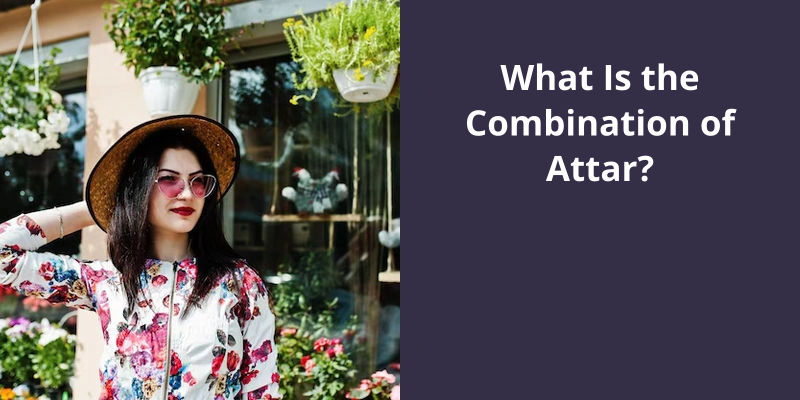Attar, also known as ittar, is a traditional type of natural perfume extracted from flowers, herbs, spices, or barks. The extraction process often involves steam distillation or hydrodistillation to get the purest form of fragrance. The ingredients and their ratios may vary based on the type of attar, the region it comes from, and the specific recipe used. Popular ingredients can include rose, sandalwood, jasmine, ambergris, and various exotic spices. This rich and concentrated oil-based perfume is free from alcohol, providing a long-lasting scent that can subtly change throughout the day, as it blends with the wearer’s natural skin oils.

What Is the Composition of Attar?
Attar, also known as ittar or itr, is a traditional perfume that’s been cherished for centuries. The composition of attar is derived from a complex and delicate process. Technically, attars are distillates made from a variety of natural materials including flowers, herbs, spices, and even baked soil. These materials are carefully selected for their fragrance and qualities.
The process of making attar involves the use of a hydrodistillation technique. This technique utilizes a still, known as deg, and a receiving vessel called bhapka. The flowers, herbs, or spices are placed in the deg along with sandalwood oil or liquid paraffins. The mixture is then heated, allowing the aromatic compounds to be extracted and condensed into the bhapka.
One of the key components in the composition of attar is the choice of floral or herbal material. Different flowers, such as rose, jasmine, or lavender, are used to create distinct scents. Similarly, herbs like vetiver, patchouli, or saffron contribute their own unique aromas. The combination of these natural materials results in a wide range of attar fragrances, each with it’s own character and appeal.
Another important element in attar composition is the use of sandalwood oil or liquid paraffins as a base. These substances provide a carrier for the aromatic compounds and help in preserving and enhancing the scent. Sandalwood oil, in particular, is highly valued for it’s woody and earthy aroma, which can complement and harmonize with the other ingredients.
The precise ratios and techniques used in the distillation process contribute to the final composition of attar. Skilled artisans and perfumers, particularly in Kannauj, India, where the traditional techniques are still practiced, have honed their craftsmanship over generations. They meticulously combine the ingredients, adjusting the distillation time and temperature to extract the desired fragrance notes.
Through the art of hydrodistillation, skilled artisans create these exquisite perfumes by carefully combining and distilling the aromatic compounds. The result is a range of unique and captivating scents that have stood the test of time.
Traditional Attar-Making Techniques: Provide a Detailed Explanation of the Hydrodistillation Process and How It Has Been Practiced for Centuries.
The combination of attar, also known as ittar, refers to the traditional process of making fragrant oils using hydrodistillation techniques. This method has been practiced for centuries in various cultures, including the Middle East, India, and Southeast Asia.
The hydrodistillation process involves the extraction of aromatic compounds from natural materials such as flowers, herbs, spices, or woods. The raw materials are placed in a distillation apparatus, usually a copper still, along with water. Heat is applied, causing the water to boil and produce steam.
The steam carries the volatile aromatic compounds from the raw materials, and it rises through the still. The steam is then condensed in a coil or condenser, resulting in a liquid mixture of water and fragrant oil. The fragrant oil, also known as attar, is lighter than water and floats on it’s surface. It’s then separated and collected.
The hydrodistillation process requires skill and precision to achieve the desired fragrance and quality of attar. Different raw materials and their combinations are used to create various scents. For example, rose petals are commonly used to make rose attar, while sandalwood is used for sandalwood attar.
Attar-making has been passed down through generations and continues to be a traditional craft in many cultures. The combination of attar represents the artistry and knowledge involved in creating these exquisite fragrances, which have been cherished for their unique scents and therapeutic properties throughout history.
Attar, known for it’s enchanting aroma, can be enhanced to achieve a longer-lasting effect by blending it with sandalwood oil. Considered a pure flower extract, the sandalwood oil acts as a base for the attar oil, resulting in a final blend that exudes lasting fragrance.
What Can I Add to Attar for Long Lasting?
When aiming for a long-lasting effect with attar oil, there are a few additives that can be incorporated to enhance it’s staying power. One of the most effective options is sandalwood oil, which acts as a base for the attar oil. With it’s pure and natural properties, sandalwood oil provides a solid foundation for the attar fragrance to thrive.
It’s woody and slightly sweet notes blend seamlessly with the floral and aromatic elements of the attar, creating a well-rounded, multi-dimensional fragrance.
It’s natural properties blend harmoniously with the attar oil, resulting in a fragrance that gradually releases it’s aromatic compounds throughout the day. When combined, these oils create a well-rounded and multi-dimensional fragrance experience that lingers on the skin.
When it comes to fragrances, attar and perfume may seem interchangeable, but there’s actually a notable difference between the two. Attar perfumes are concentrated natural fragrances derived from botanical sources in the form of base oil, while perfumes typically come in spray form as they contain alcohol. These distinctions in composition and application technique make attar and perfume distinct from one another.
Is There Any Difference Between Attar and Perfume?
Attar perfumes and regular perfumes differ in their composition and form. Attars are concentrated natural fragrances derived from botanical sources and are commonly found in oil form. These oils are obtained through the process of steam distillation or hydro-distillation, which allows the volatile aromatic compounds to be captured and suspended in a carrier oil. This traditional method preserves the true essence of the botanical ingredients, resulting in a rich and sophisticated scent.
On the other hand, regular perfumes are typically formulated using a combination of synthetic and natural aromatic compounds, mixed with alcohol and other fixatives to create a stable and long-lasting fragrance. These perfumes are commonly available in spray form, allowing for easy and even application on the skin or clothing.
The absence of alcohol in attars makes them suitable for individuals with sensitive skin, as they’re less likely to cause irritation.
Their popularity lies in their convenience and versatility, as they can be easily carried around and applied whenever desired.
Whether one prefers the concentrated and timeless essence of attars or the wide range of options offered by regular perfumes, the world of fragrances offers a diverse and captivating scent experience for all.
Source: What’s difference between attar and perfume?..
Making attar, also known as rose-water simple syrup, is a quick and effortless process that takes only 15 minutes to complete. This Middle-Eastern essential isn’t only versatile but also has a long shelf life, lasting for months in your pantry. Once you experience the delightful flavors and aroma of attar, you’ll find yourself reaching for it time and time again.
How Long Does It Take to Make Attar?
Attar, also known as rose-water simple syrup, is a crucial ingredient in many Middle-Eastern desserts. It’s exquisite aroma and delicate flavor make it a staple in the pantry of anyone who loves indulging in these sweet treats. The best part is that making attar at home is incredibly easy and doesn’t require a lot of time.
The entire process takes approximately 15 minutes from start to finish. The syrup needs time to cool down and infuse with the fragrant essence of rose water. Once cooled, the attar can be stored in a glass bottle or container and can last for months in your pantry without losing it’s potency.
This homemade attar is far superior to store-bought versions, as it uses natural ingredients and allows you to control the sweetness. The combination of attar is simple yet elegant, creating a delightful addition to any dessert. Whether you want to drizzle it over baklava, mix it into ice creams, or use it to sweeten your teas and coffees, attar brings a delightful floral touch to any dish.
Once you make attar for the first time, youll be amazed at how versatile and essential it becomes in your kitchen. It’s delicate yet distinct flavor elevates the taste of desserts and beverages, making them truly special. So, don’t hesitate to give this easy attar recipe a try and experience the joy of creating this beautiful combination of attar in the comfort of your own home.
Now that you’ve learned the basic method of mixing an attar formula, let’s explore some additional tips and tricks to enhance the fragrance and longevity of your concoction.
How Do You Mix Attar Formula?
Mixing attar requires a specific method to create the perfect combination of scents. To start, take the carrier oil, which can be almond, jojoba, or any other suitable oil, and add it to a mixing jar. The amount of oil depends on the proportion of attar you wish to create. Next, carefully select the essential oils you want to blend to create the desired fragrance profile.
Once you’ve chosen the essential oils, add them to the carrier oil in the mixing jar. Make sure to add the oils in small drops, allowing them to mix well with the carrier oil. The number of drops and combinations of essential oils will depend on your personal preference and the desired scent.
After adding the essential oils, close the lid of the jar tightly to prevent any leaks or evaporation. It’s crucial to store the mixing jar in a cool and dry place to allow the oils to blend properly over time. It’s recommended to leave the mixture for at least 48 hours to allow the scent to develop fully.
After 48 hours, you can enhance the fragrance by adding a few drops of glycerin and a few spoonfuls of water to the mixture. Mix everything thoroughly to ensure that the glycerin and water are incorporated evenly. This step helps to soften the blend and provide longevity to the attars scent.
Once you’ve mixed everything well, your attar is now ready. Transfer it to a suitable container, such as a small glass bottle with a tight lid, to preserve it’s scent and prevent any leakage. Label the container with the name of your attar blend and the date you created it for future reference.
Conclusion
In conclusion, attar, also known as ittar, is a complex and intriguing blend of aromatic compounds derived from various botanical sources. This traditional art form has been practiced for centuries, resulting in an array of fragrance profiles that are beloved by many. Whether used for personal adornment, spiritual purposes, or simply to enhance one's surroundings, attar continues to captivate and enchant those who appreciate the harmonious blend of nature's aromatic treasures.





